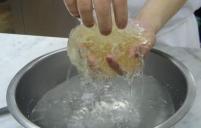Gelatin texture ?
 DUDU
Posts: 1,945
DUDU
Posts: 1,945
Hello,
I am far from being a specialist in texture and I would like to create a gelatin texture as on the image below… Actually, it will be dribble (slime ?) of Alien but textures of glass or plastics are not appropriate.
The problem is that the objects are empty inside thus the transparency of texture remains the same no matter the thickness.
Does somebody have a trick to imitate an object full inside ?
Thank you.


Gélatine.jpg
542 x 346 - 82K


Comments
Looks like you need subsurface scattering .... Never used it renders too slow, evil I think has faked it with a bit of glow ?
Look at some of the water shaders that have subsurface scattering and check out how they are made
they come with caraarra
There's a bunch of settings come under the category of subsurface scattering. I'd suggest playing particularly with fresnel and absorbtion settings. I've had good results making water for ponds & streams that way. But it is slow to render.
Forget the SSS, and use the absorption and in-scattering sub-shaders under the transparency channel.
If you use absorption, remember the color that you set, is the color that is absorbed.
In addition to setting the value for in-scattering in the sub-shader, there is also a checkbox that you need to enable when you select the top transparency shader.
Also, you will probably want refraction so that you can set the Fresnel amount in the Transparency channel.
I think what you need to play with is the inscattering settings under transparency. Start with the Attenuation Distance equal to the scene size (30in for a small scene, 30ft for a medium scene, etc.) and the In-scattering Strength at 1.00 and increase the Strength setting to make the effect stronger. You'll have to play with the color in the actual In-Scattering channel to get what you are going for.
Subsurface Scattering might also be a good way to go about this, but it's much slower to render and doesn't work well combined with objects that are mostly transparent.
Also as food for thought:
If you're trying the above suggestions and it's just not coming out as you'd expect it to, try adding thickness to the mesh. If that is simply not an option, try instead just loading that same mesh twice, and keeping the two slightly away from each other.
Reason being that some of these shader functions work best with another shader behind (or in front of) it - which requires some sort of mesh to hold it.
A good example of this is the refraction of a glass shader. A single plane will not refract correctly - often way, Way too much. Give it a second plane with the same shader, set the same distance away as the glass should be thick, and it's remarkably similar to real glass refraction.
I'm not sure if this is the case, but if you're having trouble getting a shader's functions to behave correctly, this is a good test to see if it straightens out the effect.
I don't think attenuation distance can be defined so easily. I've found that for water, if I need it murky, so that a figure standing in it appears to disappear into the depths more quickly, the value will need to be lower. A lot is also dependent on the ins-scattering and absorption.
I actually agree, but I find that setting it to match the scene size is usually a good starting point - it's just a personal rule of thumb based on my own experiments, as always your mileage may vary.
It's not a perfect shader, but here's what I whipped up for a red gelatin shader applied to cubes. I stuck it in an existing scene so I didn't have to muck around with lighting and such.
The important thing is to see how the in-scattering and absorption can add an appearance of depth and volume to what is essentially an empty space.
Sorry for the delay of my answer, but not enough days in one year to do all the work which I promised…
In any case, thank you with all for your good ideas!
I started with the EP' S settings and tested how all the modifications in the adjustments reacted.
I arrive at excellent results but not what I really seek.
I don't manage to make almost transparent the finest parts of the object, even if one feels well the difference of thickness, one don't see any transparence.
Lighting gives very variable results thus to know the truth, I removed the distant light and put the ambient light over 100%.
I also played with the alpha channel, but the effect is opposite (and also interesting).
82% in Color Chanel give almost a “ceramic” effect.
Isn't it possible to make almost transparent the finest parts ?
OK, I'm getting closer !
The intensity colour was to dark.
Thanks Kevin but, what is exactly the translucence ?
When you look at your shader tree, it is the very bottom shader channel, right below Sub-Surface Scattering
Think of it like a lamp shade or soft white light bulb. You can't see through them, but light passes through them.
These renders uses Indirect Light and has a cone/lamp shade shape with a translucent shader.
While the samples I posted are internally lit, and gelatin is not, translucency could still help with the effect.
The other thing that I forgot to mention about the absorption in my previous post, was that you could reduce the Attenuation setting. In my experience, a higher value will make the effect stronger, so that objects with less thickness appear to have a greater depth.
This is always fun, yet maddening stuff to work with.
Transparency is possilbe towards the edge of the object.
However, results vary significantly between Carrara's red-headed step child, the Metablob tool, and any vertex or primative objects. If you use both in a scene, you'll need two shaders - one for the Metablob object and one for everything else.
Also, if you engage refraction, the results of the shader also change significantly. You can tell which is which below. So, kind of a decision between something that looks slightly gasseous vs. a liquid thing. I used Water as the refraction index.